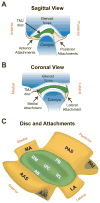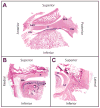The attachments of the temporomandibular joint disc: a biochemical and histological investigation
- PMID: 22129470
- PMCID: PMC3294030
- DOI: 10.1016/j.archoralbio.2011.10.004
The attachments of the temporomandibular joint disc: a biochemical and histological investigation
Abstract
Objective: The complex movement of the temporomandibular joint (TMJ) disc during mastication is controlled in large part by the disc's attachments to the surrounding tissues. This study seeks to address the lack of available quantitative data characterizing the extracellular matrix composition of the discal attachments and how these properties compare to the disc.
Design: Porcine TMJ disc-attachment complexes were carefully dissected into six discal attachments and five TMJ disc regions. All samples were assayed biochemically for total collagen, glycosaminoglycan (GAG), DNA, and hydration. Additionally, histology was performed on the whole joint to investigate the anatomy of the disc-attachment complex, and to verify the regional distribution of matrix components.
Results: Quantitative biochemical assays showed that overall water content was fairly constant in all disc and attachment regions. Disc regions generally showed higher sulfated GAG and collagen content than the attachments. In contrast, the attachments contained greater DNA content than the disc. Histological staining supported the quantitative results and also indicated more elastic fibres to be present in the attachments than the disc.
Conclusions: Although macroscopically the TMJ disc and its attachments form a seamless complex within the joint, a closer look at regional biochemical constituents reveals that these two components are distinct. Whilst the disc and attachments both contain the same major constituents, the relative amounts of these components vary based on the functional requirements of the tissue. These results can further understanding of both TMJ biology and pathology.
Copyright © 2011 Elsevier Ltd. All rights reserved.
Figures




Similar articles
-
Characterization of the Temporomandibular Joint Disc Complex in the Yucatan Minipig.Tissue Eng Part A. 2023 Aug;29(15-16):439-448. doi: 10.1089/ten.TEA.2023.0011. Epub 2023 May 29. Tissue Eng Part A. 2023. PMID: 37073459 Free PMC article.
-
The regional contribution of glycosaminoglycans to temporomandibular joint disc compressive properties.J Biomech Eng. 2012 Jan;134(1):011011. doi: 10.1115/1.4005763. J Biomech Eng. 2012. PMID: 22482666 Free PMC article.
-
Quantitative analysis and comparative regional investigation of the extracellular matrix of the porcine temporomandibular joint disc.Matrix Biol. 2005 Feb;24(1):45-57. doi: 10.1016/j.matbio.2004.11.006. Matrix Biol. 2005. PMID: 15749001 Free PMC article.
-
Histochemistry for studying structure and function of the articular disc of the human temporomandibular joint.Eur J Histochem. 2012 Feb 29;56(1):e11. doi: 10.4081/ejh.2012.e11. Eur J Histochem. 2012. PMID: 22472889 Free PMC article. Review.
-
Design characteristics for temporomandibular joint disc tissue engineering: learning from tendon and articular cartilage.Proc Inst Mech Eng H. 2007 Jul;221(5):509-26. doi: 10.1243/09544119JEIM158. Proc Inst Mech Eng H. 2007. PMID: 17822153 Review.
Cited by
-
Repair and remodeling of the mandibular head of the condylar process in four immature dogs.Front Vet Sci. 2023 Nov 8;10:1288938. doi: 10.3389/fvets.2023.1288938. eCollection 2023. Front Vet Sci. 2023. PMID: 38026680 Free PMC article.
-
The Diagnostic Yield of Cone-Beam Computed Tomography for Degenerative Changes of the Temporomandibular Joint in Dogs.Front Vet Sci. 2021 Aug 4;8:720641. doi: 10.3389/fvets.2021.720641. eCollection 2021. Front Vet Sci. 2021. PMID: 34422949 Free PMC article.
-
Articular Disc of a Human Temporomandibular Joint: Evaluation through Light Microscopy, Immunofluorescence and Scanning Electron Microscopy.J Funct Morphol Kinesiol. 2021 Feb 25;6(1):22. doi: 10.3390/jfmk6010022. J Funct Morphol Kinesiol. 2021. PMID: 33669061 Free PMC article.
-
Characterization of the Temporomandibular Joint Disc Complex in the Yucatan Minipig.Tissue Eng Part A. 2023 Aug;29(15-16):439-448. doi: 10.1089/ten.TEA.2023.0011. Epub 2023 May 29. Tissue Eng Part A. 2023. PMID: 37073459 Free PMC article.
-
Approaches to improve integration and regeneration of an ex vivo derived temporomandibular joint disc scaffold with variable matrix composition.J Mater Sci Mater Med. 2018 Sep 27;29(10):152. doi: 10.1007/s10856-018-6164-z. J Mater Sci Mater Med. 2018. PMID: 30264271
References
-
- Tanaka E, van Eijden T. Biomechanical behavior of the temporomandibular joint disc. Crit Rev Oral Biol Med. 2003;14(2):138–150. - PubMed
-
- Allen KD, Athanasiou KA. Tissue engineering of the TMJ disc: a review. Tissue Eng. 2006;12(5):1183–1196. - PubMed
-
- Wong ME, Allen KD, Athanasiou KA. Biomedical engineering handbook. Boca Raton: CRC Press; 2006. Tissue engineering of the temporomandibular joint; pp. 52–51–52–22.
-
- Tanaka E, Detamore MS, Mercuri LG. Degenerative disorders of the temporomandibular joint: etiology, diagnosis, and treatment. J Dent Res. 2008;87(4):296–307. - PubMed
-
- Rees LA. The Structure and function of the mandibular joint. Br Dent J. 1954;96:125–133.
Publication types
MeSH terms
Substances
Grants and funding
LinkOut - more resources
Full Text Sources

